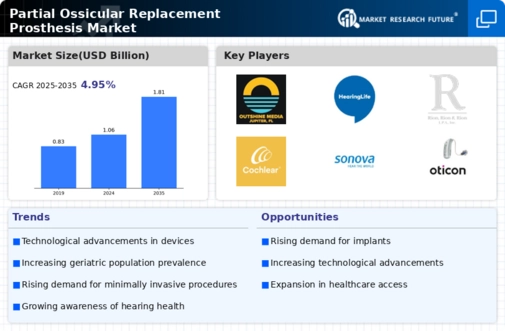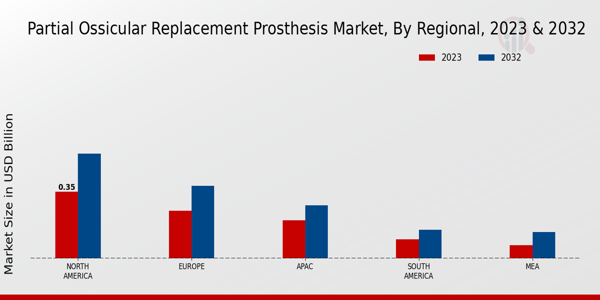Aging Population
The aging population worldwide is a crucial factor influencing the Global Partial Ossicular Replacement Prosthesis Market Industry. As life expectancy increases, the number of elderly individuals experiencing age-related hearing loss rises correspondingly. This demographic shift necessitates effective solutions for hearing restoration, thereby driving demand for partial ossicular replacement prostheses. With the market expected to reach 1.06 USD Billion in 2024, the implications of an aging society on healthcare services are profound. The need for specialized surgical interventions to address hearing loss in older adults is likely to shape market dynamics significantly.
Market Growth Projections
The Global Partial Ossicular Replacement Prosthesis Market Industry is projected to experience substantial growth over the next decade. With an anticipated market value of 1.81 USD Billion by 2035, the industry is poised for expansion driven by various factors, including technological advancements and increased healthcare spending. The compound annual growth rate of 4.96% from 2025 to 2035 indicates a robust market trajectory. This growth reflects the ongoing demand for innovative solutions in hearing restoration and the increasing recognition of the importance of addressing hearing impairments on a global scale.
Growing Awareness and Education
There is a growing awareness regarding hearing health and the available treatment options, which serves as a significant driver for the Global Partial Ossicular Replacement Prosthesis Market Industry. Educational campaigns and outreach programs are informing the public about the importance of early diagnosis and intervention for hearing loss. This increased awareness encourages individuals to seek medical advice sooner, leading to higher rates of surgical procedures. As more patients become informed about the benefits of partial ossicular replacement prostheses, the market is expected to expand, aligning with the projected growth trends in the coming years.
Increased Healthcare Expenditure
Global healthcare expenditure is on the rise, which positively impacts the Global Partial Ossicular Replacement Prosthesis Market Industry. Governments and private sectors are investing more in healthcare infrastructure, leading to improved access to surgical procedures for hearing loss. This trend is particularly evident in developing countries, where healthcare systems are expanding. As a result, the market is projected to grow to 1.81 USD Billion by 2035, reflecting the increasing willingness of patients to seek surgical interventions for hearing restoration. Enhanced funding for healthcare initiatives is likely to further stimulate demand for partial ossicular replacement prostheses.
Rising Incidence of Hearing Loss
The increasing prevalence of hearing loss globally is a primary driver for the Global Partial Ossicular Replacement Prosthesis Market Industry. According to health statistics, approximately 466 million people worldwide suffer from disabling hearing loss, a figure projected to increase significantly. This rise is attributed to factors such as aging populations and exposure to noise pollution. As a result, the demand for surgical interventions, including partial ossicular replacement prostheses, is expected to grow. The market is anticipated to reach 1.06 USD Billion in 2024, reflecting the urgent need for effective solutions to address hearing impairments.
Technological Advancements in Prosthesis Design
Innovations in the design and materials of partial ossicular replacement prostheses are enhancing their efficacy and patient outcomes. The Global Partial Ossicular Replacement Prosthesis Market Industry benefits from advancements such as biocompatible materials and improved surgical techniques, which facilitate better integration with the human body. These developments not only improve the longevity of the prostheses but also reduce the risk of complications. As the market evolves, it is likely to witness a compound annual growth rate of 4.96% from 2025 to 2035, driven by the continuous push for better surgical solutions and patient care.













